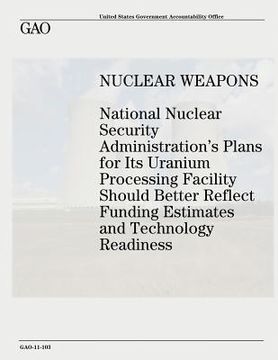Nuclear Weapons: National Nuclear Security Administration's Plans for Its Uranium Processing Facility Should Better Reflect Funding Est (en Inglés)
Reseña del libro "Nuclear Weapons: National Nuclear Security Administration's Plans for Its Uranium Processing Facility Should Better Reflect Funding Est (en Inglés)"
Built in the 1940s and 1950s, the Y-12 National Security Complex, located in Oak Ridge, Tennessee, is the National Nuclear Security Administration's (NNSA) primary site for enriched uranium activities. Because Y-12 facilities are outdated and deteriorating, NNSA is building a more modern facility--known as the Uranium Processing Facility (UPF). NNSA estimates that the UPF will cost up to $3.5 billion and save over $200 million annually in operations, security, and maintenance costs. NNSA also plans to include more advanced technologies in the UPF to make uranium processing and component production safer. GAO was asked to (1) assess NNSA's estimated cost and schedule for constructing the UPF; (2) determine the extent to which UPF will use new, experimental technologies, and identify resultant risks, if any; and (3) determine the extent to which emerging changes in the nuclear weapons stockpile could affect the UPF project. To conduct this work, GAO reviewed NNSA technology development and planning documents and met with officials from NNSA and the Y-12 plant. The UPF project costs have increased since NNSA's initial estimates in 2004 and construction may be delayed due to funding shortfalls. NNSA's current estimate prepared in 2007 indicates that the UPF will cost between $1.4 and $3.5 billion to construct--more than double NNSA's 2004 estimate of between $600 million and $1.1 billion. In addition, costs for project engineering and design, which are less than halfway completed, have increased by about 42 percent--from $297 to $421 million--due in part to changes in engineering and design pricing rates. With regard to the project's schedule, NNSA currently estimates that UPF construction will be completed as early as 2018 and as late as 2022. However, because of a funding shortfall of nearly $200 million in fiscal year 2011, NNSA officials expect that the UPF will not be completed before 2020, which could also result in additional costs. NNSA is developing 10 new technologies for use in the UPF and is using a systematic approach--Technology Readiness Levels (TRL)--to gauge the extent to which technologies have been demonstrated to work as intended. Industry best practices and Department of Energy (DOE) guidance recommend achieving specific TRLs at critical project decision points--such as establishing a cost and schedule performance baseline or beginning construction--to give optimal assurance that technologies are sufficiently ready. If critical technologies fail to work as intended, NNSA may need to revert to existing or alternate technologies, possibly resulting in changes to design plans and space requirements that could delay the project and increase costs. Changes in the composition and size of the nuclear weapons stockpile could occur as a result of changes in the nation's nuclear strategy, but NNSA officials and a key study said that the impact of these changes on the project should be minor. For example, the New Strategic Arms Reduction Treaty signed in April 2010 by the leaders of the United States and Russia would, if ratified, reduce the number of deployed strategic warheads from about 2,200 to 1,550. According to NNSA officials, NNSA and DOD have cooperated closely and incorporated key nuclear weapons stockpile changes into UPF's design. Also, an independent study found that most of the UPF's planned space and equipment is dedicated to establishing basic uranium processing capabilities that are not likely to change, while only a minimal amount--about 10 percent--is for meeting current stockpile size requirements. GAO is making five recommendations for, among other things, improving the UPF's cost and funding plans, ensuring that new UPF technologies reach optimal levels of maturity prior to critical project decisions, and for improving DOE guidance. NNSA generally agreed with the recommendations.

